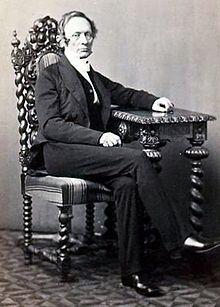Carl Gustav Homeyer
Carl Gustav Homeyer (born August 13, 1795 in Wolgast ; † October 20, 1874 in Berlin ) was a German lawyer , legal historian and Germanist .
Life
Carl Gustav Homeyer was the son of the Wolgast shipowner and grain wholesaler Johann Friedrich Homeyer and his wife Sophie Dorothea Droysen. During the Napoleonic occupation of Swedish Pomerania , the family stayed in Sweden from 1806 to 1810 . After returning he attended the Greifswald city school and the Friedrich-Wilhelms-Gymnasium in Berlin. 1813 enrolled him at the Friedrich-Wilhelms University in Berlin , where he at Friedrich Carl von Savigny , Karl Friedrich Eichhorn and Goschen Johann Friedrich Ludwig studied law. He also heard history from Friedrich Rühs . After visiting the Universities of Göttingen and Heidelberg , he received his doctorate in Berlin in 1821 with the thesis Historiae juris pomeranici capita quaedam , and in the same year completed his habilitation as a private lecturer in the law faculty.
Appointed associate professor in 1824 and full professor of law in 1827, he taught at Berlin University until 1872. He was dean of the law school three times . He gave lectures on German constitutional and legal history , private law , Prussian land law as well as trade , exchange and maritime law .
In 1845 he became a secret high tribunal councilor , which position he gave up again in 1867, in 1850 a member of the Royal Prussian Academy of Sciences , in 1854 of the State Council and in the same year crown syndic and member of the First Chamber, the later manor , for life.
As a writer, he first made a name for himself through his translation of Kolderup-Rosenvinge's Outline of Danish Legal History (Berlin 1825), and even more through his truly classic editions of the Saxon legal books, namely the Sachsenspiegel , through which he reduced the German legal source criticism to a previous one unimagined height rose.
The Landrecht of the Sachsenspiegel, which he published three times in ever more perfect form (Berlin 1827, 2nd edition 1835, 3rd edition 1861), followed as the second part The Saxon Lehnrecht and the Richtsteig Lehnrechts (1842), furthermore Der Auctor vetus de beneficiis, the Görlitzer Rechtsbuch and the System des Lehnrechts (1844), to which the Richtsteig Landrechts together with Cautela and Premis (1857) followed.
Homeyer also created a secure basis for the other German legal books with his index of German legal books of the Middle Ages and their manuscripts (Berlin 1836, reworked in 1856, completely reworked by U.-D. Oppitz in 1990). He put further comments on all of these works in numerous treatises that he read in the Academy.
He also wrote: The position of the Sachsenspiegel in relation to the Schwabenspiegel (Berlin 1853), in which writing against Alexander von Daniels he demonstrated the priority of the Sachsenspiegel over the Schwabenspiegel with convincing reasons; The position of the Sachsenspiegel on the Parentel Order (Berlin 1860).
His last, long-prepared work, on the subject of which he was led through his study of the Hantgemal (1852), was a comprehensive representation of house and court brands (Berlin 1870).
Carl Gustav Homeyer died in Berlin in 1874 at the age of 79 and was buried in the Old St. Matthew Cemetery in Schöneberg . The grave has not been preserved.
family
In 1823 he married his cousin Pauline Stenzler (* 1805), daughter of superintendent Lorenz Stenzler and his wife Charlotte Droysen. The couple had the son Gustav Homeyer (1824-1894; from 1877 Undersecretary of State in the State Ministry) and a daughter. His brother-in-law Adolf Friedrich Stenzler was professor of oriental languages in Breslau .
literature
- Ferdinand Frensdorff : Homeyer, Carl Gustav . In: Allgemeine Deutsche Biographie (ADB). Volume 13, Duncker & Humblot, Leipzig 1881, pp. 44-53.
- Gertrud Schubart-Fikentscher : Homeyer, Carl Gustav. In: New German Biography (NDB). Volume 9, Duncker & Humblot, Berlin 1972, ISBN 3-428-00190-7 , p. 589 f. ( Digitized version ).
- Deutscher Reichs-Anzeiger and Königlich Prussischer Staats-Anzeiger: 1875, no.3, p.4 , obituary
- Archive inventory
Web links
- Literature by and about Carl Gustav Homeyer in the catalog of the German National Library
- Works by and about Carl Gustav Homeyer in the German Digital Library
- Historiae juris pomeranici capita quaedam , Homeyer's dissertation from 1821 as an e-text at the HU Berlin
- Carl Gustav Homeyer at online-ofb.de
Individual evidence
- ^ Hans-Jürgen Mende: Lexicon of Berlin tombs . Haude & Spener, Berlin 2006. p. 304.
| personal data | |
|---|---|
| SURNAME | Homeyer, Carl Gustav |
| ALTERNATIVE NAMES | Homeyer, Karl Gustav; Homeyer, Carolus Gustavus |
| BRIEF DESCRIPTION | German lawyer, legal historian and Germanist |
| DATE OF BIRTH | August 13, 1795 |
| PLACE OF BIRTH | Wolgast |
| DATE OF DEATH | October 20, 1874 |
| Place of death | Berlin |

